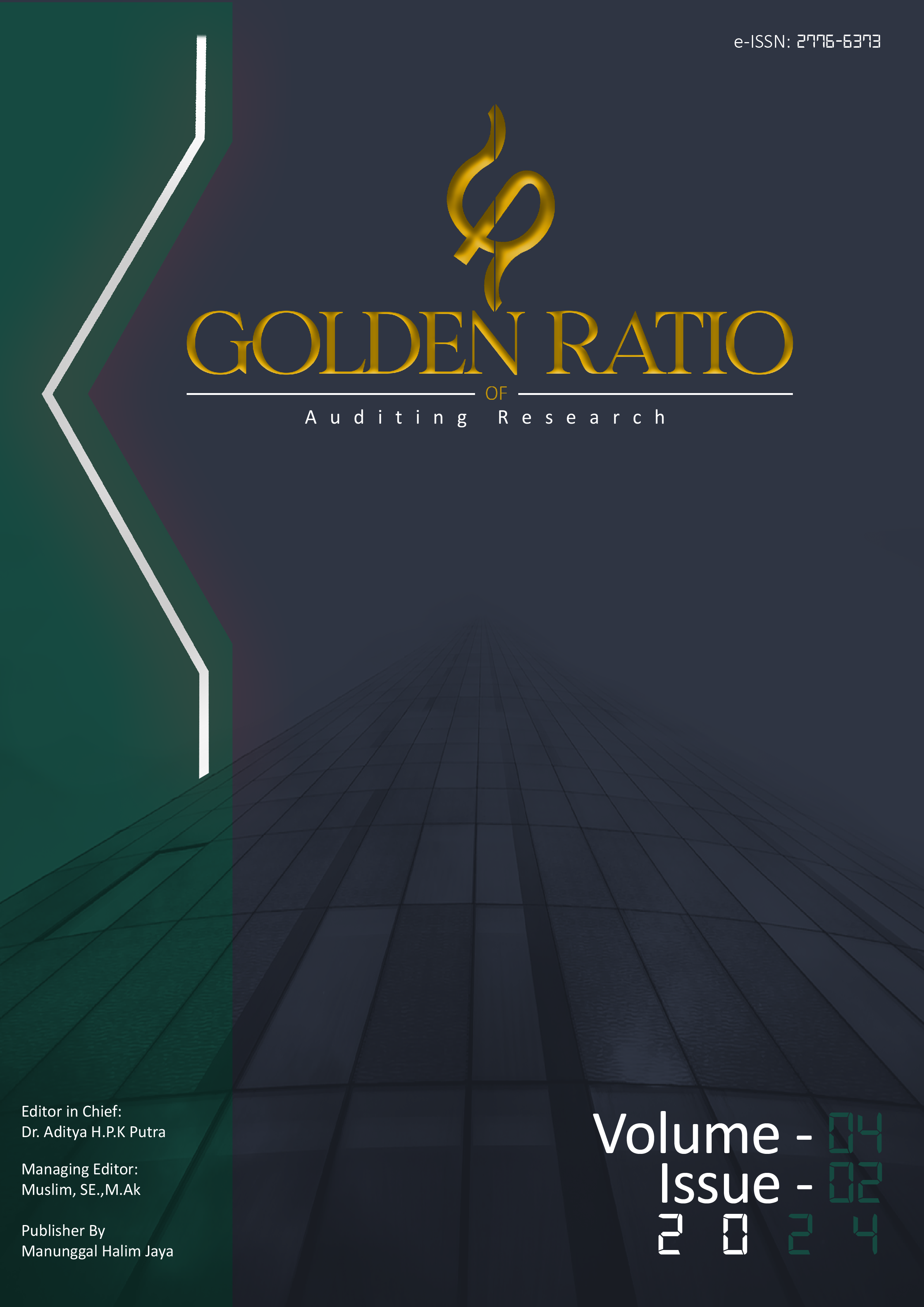Internal Audit versus External Audit: A Qualitative Perspective
Main Article Content
Abstract
This qualitative study examines the roles, methodologies, effectiveness, and challenges of internal audit versus external audit within organizational contexts. The research aims to provide insights into the distinct yet complementary functions of internal and external audit, shedding light on their contributions to organizational governance, risk management, and financial reporting integrity. The study employs a comprehensive literature review approach, synthesizing existing research to explore definitions, conceptual frameworks, methodologies, practices, and assessments of effectiveness in both audit functions. Key findings reveal that internal audit serves as a proactive advisor to management, focusing on enhancing operational efficiency, strengthening internal controls, and driving continuous improvement and innovation. Conversely, external audit acts as a safeguard for external stakeholders, providing assurance on the reliability and integrity of financial statements. Methodologies and practices vary between internal and external audit, with internal audit employing risk-based auditing, compliance auditing, and performance auditing approaches, while external audit adheres to auditing standards and regulations. Despite their distinct roles, both audit functions face challenges related to audit quality, independence, and relevance. The study underscores the importance of understanding and leveraging the multifaceted contributions of internal and external audit to navigate the complexities of the modern business environment effectively.
Article Details

This work is licensed under a Creative Commons Attribution-ShareAlike 4.0 International License.
References
Abbott, L. J., Parker, S., & Peters, G. F. (2003). Audit committee characteristics and restatements. Auditing: A Journal of Practice & Theory, 22(1), 51-73. https://doi.org/10.2308/aud.2003.22.1.51
Al-Twaijry, A. A., Brierley, J. A., & Gwilliam, D. R. (2004). The development of internal audit in Saudi Arabia: A survey of the public sector. Managerial Auditing Journal, 19(1), 80-95. https://doi.org/10.1108/02686900410515574
Brown, K., Jones, M., & Wilson, T. (2022). Continuous auditing: A proactive approach to risk management. Journal of Accounting Information Systems, 25(3), 321-338. https://doi.org/10.1016/j.jais.2016.06.001
Cascarino, R. (2017). Internal auditing: An integrated approach (4th ed.). Pearson.
Chan, D. Y. L., Chow, C. W., & Landsman, W. R. (2016). The effectiveness of internal audit outsourcing: An empirical examination. Journal of Accounting Research, 54(1), 215-249. https://doi.org/10.1111/1475-679X.12126
Chen, C. X., & Chan, J. Y. (2021). Internal audit and cybersecurity risk management: Evidence from top audit executives. International Journal of Accounting Information Systems, 43, 100542. https://doi.org/10.1016/j.accinf.2021.100542
DeFond, M. L., & Zhang, J. (2014). A review of archival auditing research. Journal of Accounting and Economics, 58(2-3), 275-326. https://doi.org/10.1016/j.jacceco.2014.06.004
Edds, P. (1981). The role and status of the internal auditor: An empirical investigation. Accounting, Organizations and Society, 6(4), 357-369. https://doi.org/10.1016/0361-3682(81)90014-2
Fazlida, I. (2015). Internal audit quality and external audit reliance: Evidence from Malaysia. Procedia Economics and Finance, 31, 525-535. https://doi.org/10.1016/S2212-5671(15)01171-5
Goodwin, J. (2004). Internal auditing in the public sector: A review of the literature. International Journal of Auditing, 8(3), 259-280. https://doi.org/10.1111/j.1099-1123.2004.00211.x
Hegazy, S. (2021). The relationship between audit committee and internal audit function: The Egyptian context. International Journal of Auditing, 25(3), 579-589. https://doi.org/10.1111/ijau.12220
Hermanson, D. R., Rittenberg, L. E., & Houston, R. W. (2020). Internal auditing: Assurance & advisory services (5th ed.). McGraw-Hill Education.
IIA. (2018). Global internal audit common body of knowledge (CBOK) 2017. Institute of Internal Auditors. Retrieved from https://na.theiia.org/standards-guidance/Public%20Documents/IPPF/2017%20CBOK%20Summary%20Report.pdf
Janvrin, D. J., Bierstaker, J. L., & Lowe, D. J. (2019). Internal audit quality and financial reporting quality: The joint importance of independence and competence. Auditing: A Journal of Practice & Theory, 38(2), 63-89. https://doi.org/10.2308/ajpt-52161
Jones, P., & Smith, R. (2023). Hybrid auditing: Combining risk-based auditing with data analytics techniques. International Journal of Auditing, 27(1), 243-265. https://doi.org/10.1111/ijau.12200
Kantor, J., Arel, B., & George, A. (2019). The internal audit handbook: The professional practice guide to auditing. Wiley.
Lennox, C. S. (2019). Auditors and regulation. Journal of Accounting and Economics, 68(2-3), 101278. https://doi.org/10.1016/j.jacceco.2019.101278
Li, X., & Wang, Y. (2023). Artificial intelligence in auditing: Opportunities and challenges. Journal of Emerging Technologies in Accounting, 20(1), 1-21. https://doi.org/10.2308/jeta-53133
Mihret, D. G., & Yismaw, A. W. (2007). Internal audit effectiveness: An Ethiopian public sector case study. Managerial Auditing Journal, 22(5), 470-484. https://doi.org/10.1108/02686900710750416
Morrill, K. A. (2003). A review of the role of the internal audit function in the corporate governance process. Journal of Accounting Literature, 22, 154-187.
Neri, L. (2014). Audit quality: A conceptual exploration. Managerial Auditing Journal, 29(7), 650-672. https://doi.org/10.1108/MAJ-05-2013-0854
Rittenberg, L. E. (2001). Internal audit independence: An analysis of alternative client-auditor relationships. Managerial Auditing Journal, 16(3), 139-148. https://doi.org/10.1108/02686900110385598
Sawyer, L. B., Dittenhofer, M., & Scheiner, J. H. (2018). Sawyer's internal auditing: The practice of modern internal auditing (7th ed.). Protiviti.
Smith, A., Johnson, B., & Brown, K. (2023). Integrating sustainability into internal audit practices: A review of current trends. Sustainability Accounting, Management and Policy Journal, 14(3), 481-504. https://doi.org/10.1108/SAMPJ-02-2023-0016
Trotman, K. T., & Trotman, A. J. (2019). How internal audit's role affects the value that external audit provides to the audit committee. Accounting, Organizations and Society, 76, 40-58. https://doi.org/10.1016/j.aos.2018.12.003
Wang, Q., & Li, J. (2024). Regulatory reforms and external audit quality: Evidence from the European Union. Accounting, Organizations and Society, 95, 1-20. https://doi.org/10.1016/j.aos.2023.101274
Zhang, M., & Chen, X. (2023). Predictive analytics in external auditing: Evidence from audit firms. Journal of Accounting and Public Policy, 42(2), 100840. https://doi.org/10.1016/j.jaccpubpol.2023.100840
